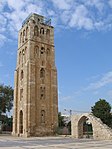The 1948 Palestinian exodus from Lydda and Ramle, also known as the Lydda Death March, was the expulsion of 50,000 to 70,000 Palestinian Arabs when Israeli troops captured the towns in July that year. The military action occurred within the context of the 1948 Arab–Israeli War. The two Arab towns, lying outside the area designated for a Jewish state in the UN Partition Plan of 1947, and inside the area set aside for an Arab state in Palestine, subsequently were transformed into predominantly Jewish areas in the new State of Israel, known as Lod and Ramla.The exodus, constituting "the biggest expulsion of the war", took place at the end of a truce period, when fighting resumed, prompting Israel to try to improve its control over the Jerusalem road and its coastal route which were under pressure from the Jordanian Arab Legion, Egyptian and Palestinian forces. From the Israeli perspective, the conquest of the towns, designed, according to Benny Morris, "to induce civilian panic and flight", averted an Arab threat to Tel Aviv, thwarted an Arab Legion advance by clogging the roads with refugees – the Yiftah Brigade was ordered to strip them of "every watch, piece of jewelry, or money, or valuables" – to force the Arab Legion to assume an additional logistical burden with the arrival of masses of indigent refugees that would undermine its military capacities, and helped demoralise nearby Arab cities. On 10 July, Glubb Pasha ordered the defending Arab Legion troops to "make arrangements ... for a phony war". The next day, Ramle surrendered immediately, but the conquest of Lydda took longer and led to an unknown number of deaths; the Palestinian historian Aref al-Aref, the only scholar who tried to draw up a balance sheet for the Palestinian losses, estimated 426 Palestinians died in Lydda on 12 July, of which 176 in the mosque and 800 overall in the fighting. Israeli historian Benny Morris suggests up to 450 Palestinians and 9–10 Israeli soldiers died.Once the Israelis were in control of the towns, an expulsion order signed by Yitzhak Rabin was issued to the Israel Defense Forces (IDF) stating, "1. The inhabitants of Lydda must be expelled quickly without attention to age....". Ramle's residents were bussed out, while the people of Lydda were forced to walk miles during a summer heat wave to the Arab front lines, where the Arab Legion, Transjordan's British-led army, tried to provide shelter and supplies. A number of the refugees died during the exodus from exhaustion and dehydration, with estimates ranging from a handful to a figure of 500.The events in Lydda and Ramle accounted for one-tenth of the overall Arab exodus from Palestine, known in the Arab world as al-Nakba ('the catastrophe'). Some scholars, including Ilan Pappé, have characterised what occurred at Lydda and Ramle as ethnic cleansing. Many Jews who came to Israel between 1948 and 1951 settled in the refugees' empty homes, both because of a housing shortage and as a matter of policy to prevent former residents from reclaiming them. Ari Shavit noted that the "events were crucial phase of the Zionist revolution, and they laid the foundation for the Jewish state."









